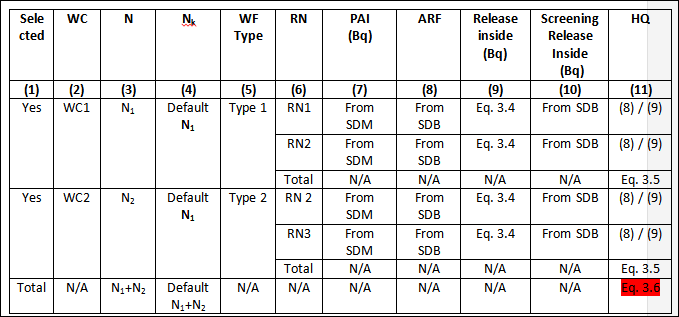Impacts inside only
For quantification of impacts inside the facility of the type direct “releases to air” SAFRAN uses the following procedure (see Table 3.4):
For each waste component selected by the user (column 1) SAFRAN obtains from the Database values of the Airborne release fraction(ARF). The ARFs are the fraction of the PAI (radionuclide specific) that is released to air during the accident and depend on the type of effect of the accident (for example thermal effect in case of fires) and the waste form type of the affected waste component. The SAFRAN Internal Database contains values of the ARF for a number of elements, types of effects and types of waste forms. The user can add own values of ARF to the database , as well as new types or effects and of waste forms.
For each affected waste component SAFRAN calculates the radionuclide releases inside (column 9) by multiplying the number of affected waste components (column 4) by the PAI (column 7) and the ARF (column 8):

For storage areas the number of affected waste components (column 4) is as default set equal to the number of potentially affected waste components (column 3). For processing areas the default value of the number of affected waste components (column 4) is 1, since the PAI refers to the inventory involved in the process.
The HQs (column 11) for each radionuclide and waste component are obtained by dividing the calculated releases inside (column 9) by the Screening Release Inside (column 10). The Screening Release Inside values are taken from the SAFRAN Internal Database (SDB). These are release rates inside a room that will give a dose of equal to the Screening Dose for accidents (assumed equal to 0.1 mSv) to a person that is exposed to the release during one hour at a distance of one meter from the release point. The Screening Release Inside are derived for standardized conditions under conservative assumptions.
For each waste component the total HQ is obtained by adding the HQs of all radionuclides released:

The overall HQ from all affected waste components and released radionuclides is then:

The total releases inside of each radionuclide are not shown in Table 3.4, but are saved by SAFRAN and can be used as input for assessment of impacts outside and exposure assessments. These are calculated as:

Table 3.4. Quantification of impacts inside the facility of the type “releases to air”.

WC – waste component, N- number of waste components, WF Type – type of waste form, RN – radionuclide, PAI – Potentially Affected Inventory, ARF (Airborne Release Fraction), HQ – Hazard Quotient, SDM – System Description Module, SDB – SAFRAN Internal Database, N/A – not applicable. The cell marked in read is used in the Analysis Module for comparison of hazards.
Definition of columns in Table 3.4:
- Column 1. For selecting included WCs.
- Column 2. Short name of the Waste Components (WC).
- Column 3. Number of units for each WC.
- Column 4. Number of affected units for each WC.
- Column 5. Waste Form Type for each WC or process.
- Column 6. Short name of the radionuclides (RN).
- Column 7. PAI for each WC.
- Column 8. Airborne Release Fractions (ARF).
- Column 9. Releases inside for each WC.
- Column 10. Screening releases inside.
- Column 11. Hazards Quotient.
Columns in Table 3.4 that can be modified by the user: The user can modify the following columns: column 1 – to select waste components, column 4 – to define number of waste components affected, column 8– for entering directly the ARF, column 9 – for entering directly values of Release inside and column 10 – for entering own values of the Screening Release Inside.